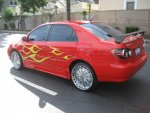So is it pre-ignition or detonation?
LSPI isn't so much knock, as oops, your rod just exploded.
I wanted to better understand, and so With more reading I find ^ statement is ohhhhh so true. Here's something from Allen Cline in an article in Contact! Magainze# (also a GM engineer

, more on that in a bit):
"...Remember, the spark plug ignites the mixture and a sharp pressure spike occurs after that, when the detonation occurs. That's what you hear. With pre-ignition, the ignition of the charge happens far ahead of the spark plug firing, in my example, very, very far ahead of it when the compression stroke just starts. There is no very rapid pressure spike like with detonation. Instead, it is a tremendous amount of pressure which is present for a very long dwell time, i.e., the entire compression stroke. That's what puts such large loads on the parts. There is no sharp pressure spike to resonate the block and the head to cause any noise. So you never hear it, the engine just blows up! That's why pre-ignition is so insidious. It is hardly detectable before it occurs. When it occurs you only know about it after the fact. It causes a catastrophic failure very quickly because the heat and pressures are so intense."
This also debunks the other GM presenter

in a video linked in an earlier post in this thread (28:00~) where the presenter said their test looked for pre-ignition at peak compression, as if it is some normal occurrence they try to make happen less often. That doesn't fit the description of the catastrophic nature of LSPI and/or pre-ignition at all because it's detonation that's on the downstroke causing piston ringing. Again, the article:
"There is another factor that engineers look for to quantify combustion. It is called "location of peak pressure (LPP)." It is measured by an in-cylinder pressure transducer. Ideally, the LPP should occur at 14 degrees after top dead center. Depending on the chamber design and the burn rate, if one would initiate the spark at its optimum timing (20 degrees BTDC, for example) the burn would progress through the chamber and reach LPP, or peak pressure at 14 degrees after top dead center. LPP is a mechanical factor just as an engine is a mechanical device. The piston can only go up and down so fast. If you peak the pressure too soon or too late in the cycle, you won't have optimum work. Therefore, LPP is always 14 degrees ATDC for any engine."
So how scary is engine knock then? The article:
"One thing to understand is that detonation is not necessarily destructive. Many engines run under light levels of detonation, even moderate levels. Some engines can sustain very long periods of heavy detonation without incurring any damage. If you've driven a car that has a lot of spark advance on the freeway, you'll hear it pinging. It can run that way for thousands and thousands of miles. Detonation is not necessarily destructive. It's not an optimum situation but it is not a guaranteed instant failure."
So do we just ignore occasional engine knock?
I really enjoy these forums because you can read on builds where they are dialing out the knock for performance gains. Recap, knock=power loss due to knock sensor signaling for timing to calm down aka knock retard (KR) aka GTI converted to Corolla (used for educational purposes).
Did you ever experiment with different fuels/octanes? From your description, if they were available, one of the first things I would have tried would have been different brands of gas, ethanol mix, octane booster etc.
Man I love these forums! No, I have not ^ and I'm kicking myself for not doing that first along with the good knock logs. Oh, BTW, I'm finding out quick that OBD style logging is slow and just isn't cutting it. Going to have to tap into VCDS power at some point.
For kicks, Fifth Gear did a test on, well what do you know, another VW GTI... and found that brands do matter. I'm leaning toward Shell V 91 at the moment.
https://youtu.be/WTaBngvsPrc
#
http://www.contactmagazine.com/Issue54/EngineBasics.html



